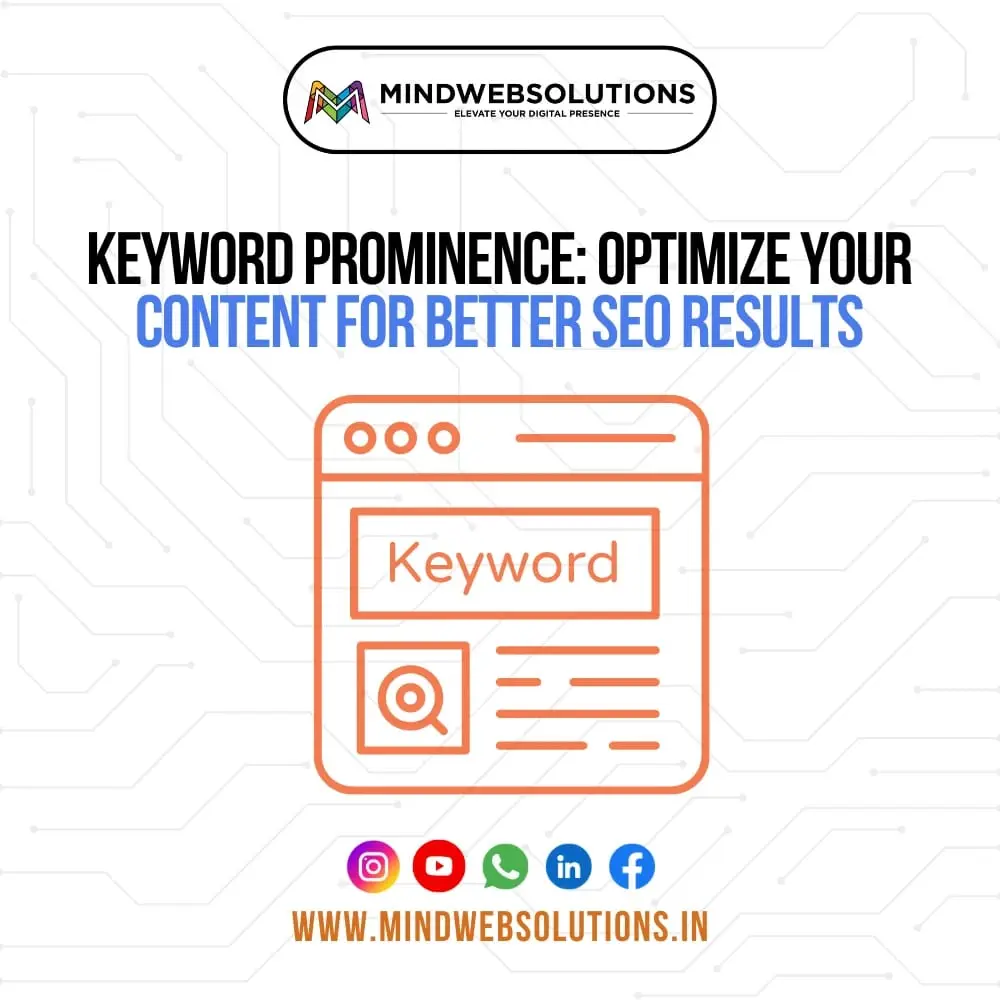What Is Keyword Prominence In SEO
Keyword prominence in the context of SEO refers to where your target keyword appears on a webpage. The earlier or frequent the keyword appears, the better it is for SEO and users.
It involves placing keywords in important parts of your content, such as:
- Title
- Heading
- URL slug
- Image Captions
- Meta Description
- First 100 words of your blog
When Google crawls to your website, the first thing it notices is how prominently the keywords are placed in the copy of your page. Early and frequent use of target keywords in your title or the first sentence of your paragraph increases relevance for the topic.
Here’s one keyword prominence example to help to understand better.
Suppose you are writing an SEO guide about “What is Keyword Prominence in SEO.” So, you, as a writer, must include this target keyword in important places. Like at the beginning of your introduction, in your headings, and within the body. Doing so signals Google that this article is relevant for so and so keywords and talks about it.
Besides, keyword prominance also impacts user experience. This is because when the users land on your website, they skim the content roughly to get an idea about the relevance of the content.
Only if they find value in the content and feel “Yes, this is the right page I have landed on” would they read further.
In short, to sum it up again for you:
- When you use the keywords early, Google understands the content’s focus and relevance. Hence, it ranks your website higher on search engine page results (SERPs).
- The snippet, meta title, and headings all play an important role in influencing your audience’s psychology.
- Users don’t just randomly visit your website; they click on the results that solve their query or address their pain points.
How Does Keyword Prominence Differ From Keyword Density And Proximity?
It is natural to confuse Keyword density, keyword prominence and proximity. They might sound similar but do not mean the same.
We already discussed keyword prominence above; let us discuss how it differs from the other two.
Keyword density is the number of times your seed keyword appears in the content. For example, you read a 1000-blog on “Why is keyword research important for SEO.”
You notice the primary keyword “Why is keyword research important” appears 10 times in its entirety. So, the keyword density for your article is the percentage ratio to total word count, i.e. 10/1000 = 1%
Now, while the frequency of keywords in an article is important, it shouldn’t reach a level where it comes off as spam content . It is all about creating a balance between the density and prominence of the keywords.
Keyword proximity focuses on the closeness or distance of words in a keyword phrase.
For the keyword “SEO strategy for beginners,” the closer the words “SEO” and “beginners” appear together, the better.
If you look closely, keyword prominence SEO is about the placement of the main keyword, while proximity is about how close they are placed.

What Is The Ideal Keyword Placement For Maximum Prominence?
The higher up the keywords appear in the content, the maximum SEO results can be seen.
But how do you determine the ideal spots for keyword placement? Let’s start with the most important areas.
- H1, H2, H3 Tags – The Headings
The first place to use your primary keyword is in the headings:
H1 tags serve as the title of your page for users. Placing the relevant keywords in H1 gives instant attention to readers that the page they have landed is accurate for their query or search intent.
Your H2 tags, which serve as subheadings, are the next most prominent spots. These break your content into sections and should also contain your keywords naturally. You don’t need to force it, but if it fits, use it.
Finally, we have H3 tags, which are used for further sub-sections within your H2 topics.
- Introduction
Including your keyword in the first 100-150 (as discussed above in the article) words of your introduction is a must. As search engines give more weight to keywords. And it’s if they appear early.
- Body Text
Semantically spreading the important words throughout the body text, like in the first few paragraphs, mid-section, and closing statements, serves well for your SEO.
But don’t overdo it—your content should serve the readers first.
What Factors Influence Keyword Prominence In SEO?
Several factors contribute to enhancing keyword prominence:
- Content Structure – Clear headings, subheadings, and organized paragraphs improve visibility.
- Strategic Placement – Keywords positioned higher in the content are more likely to catch Google’s attention.
- Internal Links – Linking internally with anchor text containing your target keyword boosts prominence.
Above all, HTMl formatting of your page also works behind the scenes to improve your prominence. Here’s how:
Impact Of Html Tags On Keyword Prominence
HTML tags like <title>, <h1>, and meta descriptions play a key role in enhancing keyword prominence.
- Title Tag
Your title tag is your first chance to catch both users’ and search engines’ attention. Ensure that your primary keyword is included here.
- Meta Descriptions
These are brief descriptions that you see below the meta title. Meta descriptions,in 150-160 characters, tell what the page is about. So, including keywords in meta descriptions help users quickly know what to expect before opening the page. This way, they also help increase the CTR of your page.
Above all, provide value-rich and well researched content for your readers. Instead of overdoing with the SEO, don’t forget to serve the purpose of your audience.
How Does Keyword Prominence Affect User Engagement?
It’s not just search engines that care about keyword prominence—users do too. When a keyword is prominently displayed, it catches the reader’s eye, making the content more engaging.
This increases:
- CTR rates
- User Retention
- Website Authority
- Rankings on SERPs

What Are Common Mistakes To Avoid When Optimizing Keyword Prominence?
Gone are the days when over stuffing the keywords in your blogs would work. Now, Google penalizes such spammy content.
Read the below paragraph for better clarity:
“If you’re looking for the best shoes online, the best option is to search for the best shoes online using websites that sell the best shoes online. This way, you can easily find the best shoes online without leaving your house.”
The whole thing sounds so unnatural and doesn’t flow well too.
The keyword “best shoes online” repeats four times in 40 words. That’s too much.
Such errors can badly hurt your SEO scores while taking away the interest of readers too.
Always aim for a natural-sounding tone for writing while placing your keywords in key positions. Avoid overusing for the namesake to satisfy search engines.
Apart from this another mistake to avoid is using irrelevant keywords that are not needed. It only reduces the value of your SEO-strategy.
Are There Any Tools To Measure And Improve Keyword Prominence?
Yes, some tools can help measure and improve your keyword prominence, like:
- Yoast SEO: Offers real-time keyword analysis feature, showing how prominent your keyword is within your content.
- SEMrush: Provides insights on keyword placements and On-page SEO suggestions.
- Ahrefs: Tracks keyword rankings and shows where your keywords are placed on the page.
- Rank Math: Another SEO tool that helps optimize content for better visibility.
Frequently Asked Questions About Keyword Prominence
Keyword prominence means how visibly and early your target keyword appears in the content. It simply refers to placement in important places like titles, headings, meta description, body, etc.
Effective keyword prominence signals the search engine that your copy is relevant to the user’s intent. It makes your page stand out visually.






